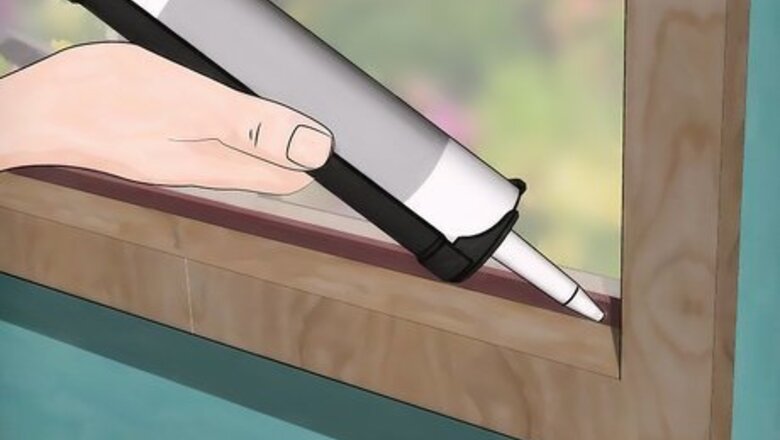
views
- Sprinkle table salt, talcum powder, or diatomaceous earth across doorways and windowsills to deter ants from entering your home.
- Make a natural ant repellent by using one or more of vinegar, peppermint oil, cinnamon, black pepper, cayenne pepper, whole cloves, or bay leaves
- Prevent ants from wandering into your house by sealing off entranceways with caulk and using airtight food containers.
Keeping Ants Out of Your Home

Seal cracks in windowsills and doorways with caulk. Close the gaps around windows, doors, and walls. This way, ants won’t be able to squeeze into tight spaces and get into your house. An additional benefit of sealing off your home: more effective temperature control and thus lower energy bills. This is the least risky where kids and pets are concerned.
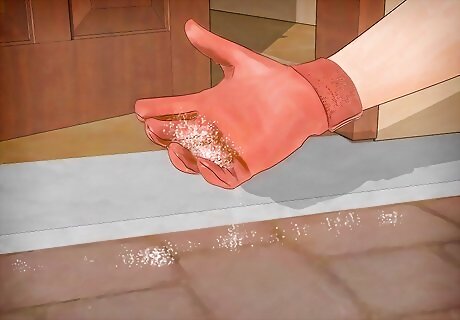
Line entryways with diatomaceous earth, salt, or commercial poison. Using anti-ant substances to keep ants out of your house is a more aggressive tactic than caulking the cracks. These fine substances create a barrier of chemicals that repel or even kill ants. Diatomaceous earth is a fine, natural powder that kills ants by pulling the moisture from their bodies. Just be careful using it, as you don't want anyone in the house sniffing it up. Place the powder in back corners and hidden spaces to prevent children or pets from getting to it. Table salt has a similar drying-out effect on ants, especially if they carry it back to their nests. Spread it under doors, near windows, and along the edges of your walls. Repelling insecticides help keep ants out by chemically killing them on contact. Simply spray the product along windowsills and/or doorways.
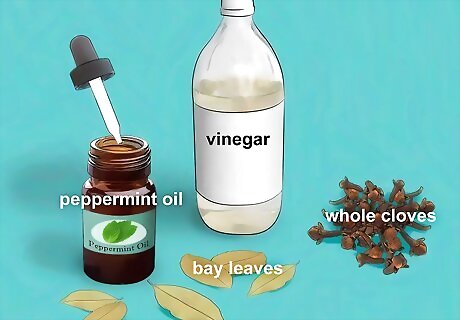
Make a nontoxic ant deterrent with white vinegar and/or cayenne pepper. Believe it or not, you may have what you need to protect your home in your pantry. Ants have mild to severe reactions or aversions to specific smells. Consider using one or more of the following ingredients to create a DIY ant repellent: vinegar, peppermint oil, cinnamon, black pepper, cayenne pepper, whole cloves, and bay leaves. Place the ingredients in a spray bottle, and spray the substance over doorways and windowsills. Use caution when using spicy ingredients such as peppers, as they may cause reactions in children and pets.

Make a tape barrier along entryways. Line your kitchen with adhesive tape sticky-side up. No poison or messy powders are necessary, making this method safe for kids and pets. When ants try to climb over the tape, they may stick to the adhesive and be stopped in their tracks. Place the tape on the edge of walls, counters, or floors where ants have been roaming. Make sure the ants can't crawl under the tape; otherwise, it may be ineffective. Use double-sided tape for the best results.

Dust talcum powder over high traffic areas to make a barrier. Although there isn’t much science backing it up, many believe talc (in its many various forms) can help deter ants. Tailor’s chalk and baby powder may contain talc, so try using them to deter ants. Regardless of which form of talc you use: keep in mind that talc has been called out as a potential carcinogen (cancer-causing substance). Some baby powder brands are made of corn starch, so they won’t work effectively against ants. Check the ingredients before you purchase anything. Many sources recommend using regular chalk; however, this is made of gypsum, not talc. This misconception could result from confusion with “ant chalk,” an insecticide that looks just like normal chalk that was outlawed in the US in the 1990s.
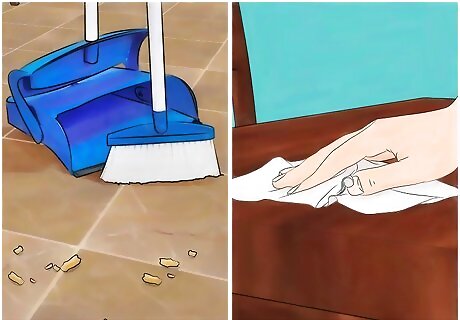
Don't leave food out. If ants come into your home, they’re most likely looking for a food source. Do your best to keep high-traffic food areas (like your kitchen and dining room) clean. Wipe up any spills or crumbs when they happen, and avoid leaving food unsealed out in the open. Clean with a mild bleach or vinegar solution to prevent ants from returning. Kill ants and clean a surface with Windex, as the ammonia solution kills ants on contact. If you do accidentally leave something out, take the opportunity to trace the trail of ants back to their source. It can be tempting to wipe out a swarm immediately, but knowing where they live can help prevent further infestations.

Store food in airtight containers. Even if you’ve stashed your food in a cupboard, ants can still find their way in through the smallest holes. If they can smell it and reach it, they’ll swarm it. Always put your food in airtight containers to prevent any insects from getting inside. Try washing out resealable containers—such as a yogurt tub, plastic takeout box, or sealable plastic bag—then reusing them to store food. Consider buying Tupperware or another brand of standardized, sealed containers. Keeping track of your containers (lids and bottoms) may be easier if you’re using a uniform set.
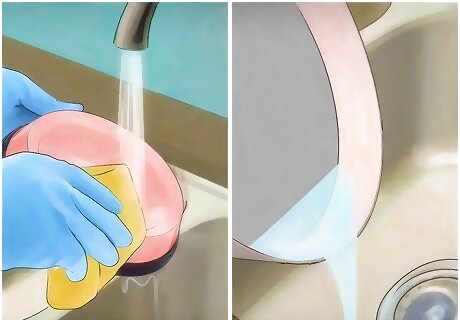
Keep your sink clean. Remember, if there’s nothing for ants to eat, they likely won’t come into your living space. Avoid leaving dirty dishes and standing water in your sink. Instead, opt to clean everything right away whenever you can. The more sanitary the environment, the less likely ants will come.
How to Kill Ants

Squish the scouts to keep other ants from coming. Colonies regularly send out lone ants (or scouts) to check for food sources. If you see an individual ant strolling across your coffee table, don't let it make it back to its nest alive. Use your finger or a napkin to squish the ant on the spot. This way, other ants won’t be able to follow their trail. Spray where the ant crawled with an all-purpose cleaner or bleach solution, then wipe it with a wet paper towel. Now there will be absolutely no trail or path for other ants to follow. For a less hands-on solution, vacuum scouts up. Then, suck up some talcum powder or diatomaceous Earth to finish off the ants inside the vacuum.
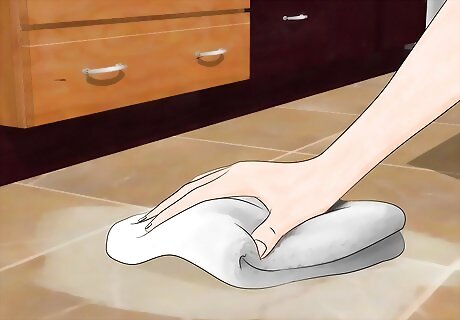
Use water to drown a large number of ants. If ants are all over your wood or tile floor, throw water over them and wipe them up with a paper towel. If ants are on your bed, get a good handful of paper towels and a cup of water. Dip the towels into the water. Squeeze to let out all the extra water, and then wipe them up. Repeat this process as needed until all the ants are gone.
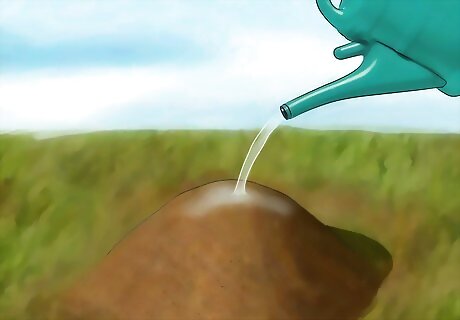
Bring down the nest with boiling water. If ants continue to raid your home, consider raiding theirs. Locate the nest and pour several gallons of boiling water into it to kill most of the ants instantly. Nests typically look like large, dome-shaped mounds of dirt. Keep in mind that boiling water can also destroy and kill the vegetation around the ant nest.
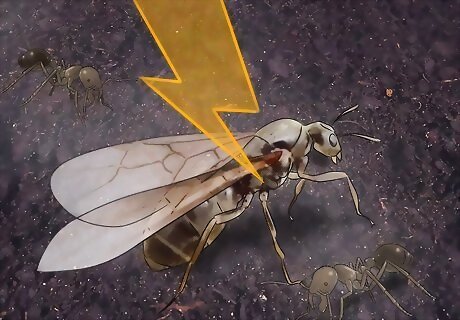
Kill the queen to disrupt the colony. The most permanent way to eliminate ants is to destroy their source: the queen ant. The queen produces a large number of ants and gives direction to the nest. Therefore, if you destroy her, you destroy the ants. Look for the queen at the center of the ant nest, and use boiling water or pesticide to wipe her out. Consider hiring an exterminator if you’re unsure where the ant nest or queen is.
DIY Ant Trap

Mix Borax with maple syrup to make your ant poison. Boric acid (or Borax) affects ants externally and internally, making it the perfect bait. The ants bring the poison to their colony and spread it around. Use a 1:3 ratio when making your poison, combining ⁄4 c (6.0 fl oz) of maple syrup with ⁄4 c (2.0 fl oz) of Borax. If you get the quantity and timing right, you can wipe out a large colony, but it can take anywhere from several weeks to a few months. Be sure to follow these increments, as a bait that’s too strong will kill the ants before they make it home, and a bait that's too weak will only weaken the colony temporarily. Borax may not work on specific ants in your region. If you have a serious ant problem, always contact an experienced exterminator for help. If you don’t feel like DIYing your ant bait, no worries! Buy commercial ant bait instead, and follow the instructions on your chosen product.

Administer the bait. Place a dollop of the mixture on an upturned lid or a low dish for easy access. Then, set the item with the mixture in an area where you’ve seen the ants. If you have pets or small children, leave the bait in a container that allows ants to enter but isn't wide enough for larger creatures. For instance, shake the poison into the bottom of a metal can. Crush one side of the can, but leave a gap that is just thin enough for ants to get inside.
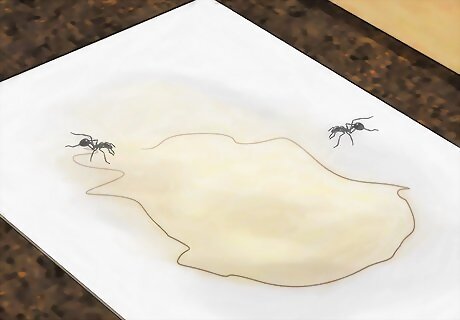
Wait for the ants to show up. Remove any deterrents or insecticides (if you used them). The idea of baiting is to attract the ants so that they’ll defeat themselves. Let the ants come into your home, and avoid squishing them.

Move the bait closer and closer to the nest. Once there's a line of ants, place the bait next to the trail. The mass of ants will shift to swirl to pick up the sweet bait and carry it back home, killing more members of the colony. Avoid placing the bait directly on the ant trail. You'll confuse them and interrupt their march home, making the baiting less effective.










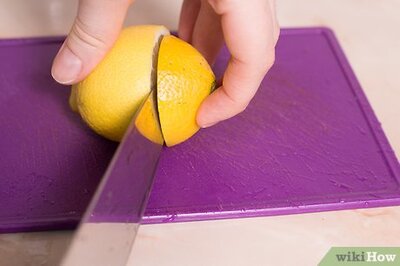


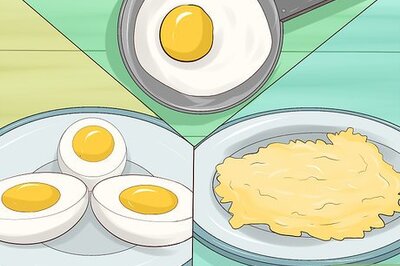

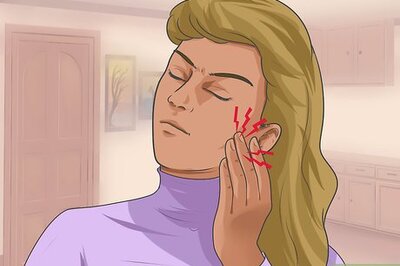
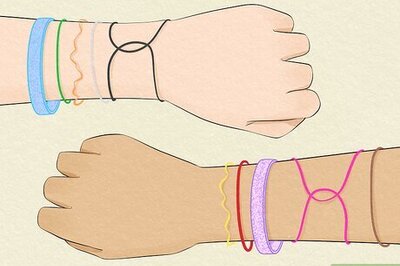
Comments
0 comment